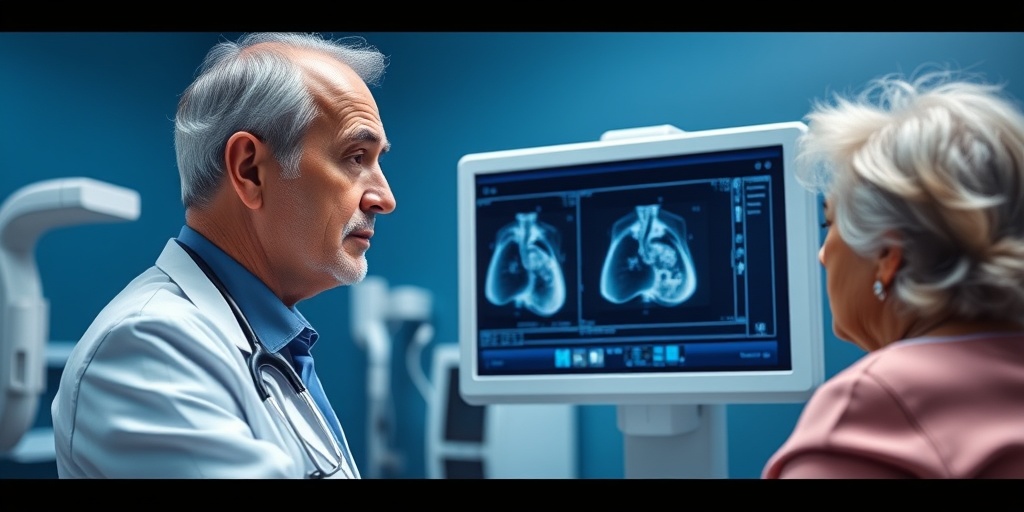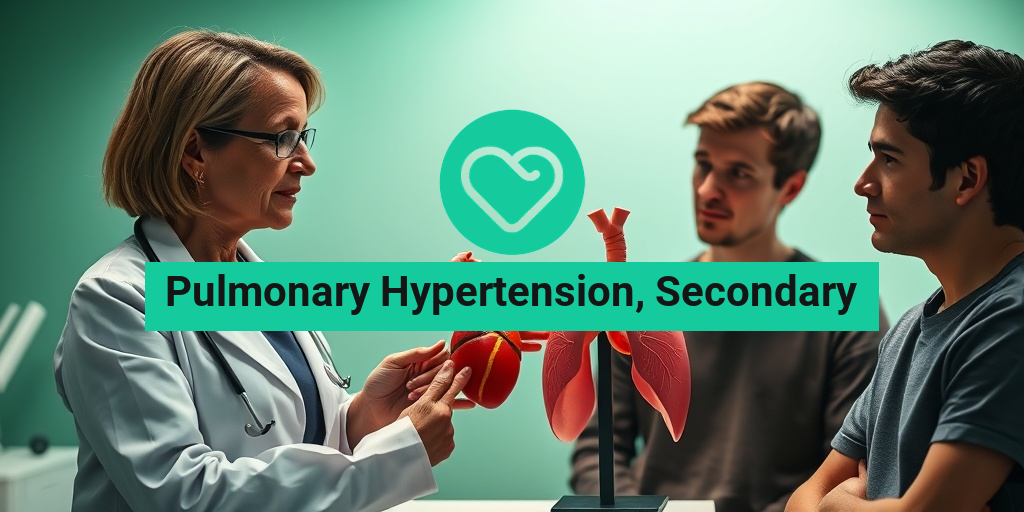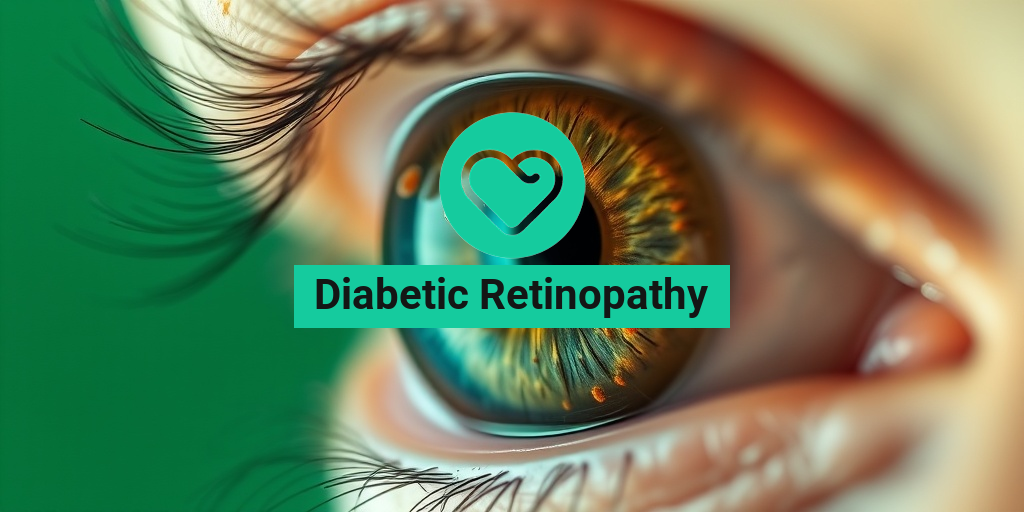What Is Pulmonary Hypertension?
Pulmonary hypertension (PH) is a serious condition characterized by elevated blood pressure in the pulmonary arteries, which are the vessels that carry blood from the heart to the lungs. This increased pressure can lead to various complications, including heart failure, and significantly impacts a person’s quality of life. Understanding pulmonary hypertension is crucial for early diagnosis and effective management.
In a healthy individual, the pressure in the pulmonary arteries is relatively low, allowing for smooth blood flow. However, in those with pulmonary hypertension, the arteries become narrowed or blocked, making it difficult for blood to flow through. This can result in symptoms such as shortness of breath, fatigue, chest pain, and even fainting spells. If left untreated, pulmonary hypertension can lead to severe complications, including right-sided heart failure.
Causes of Pulmonary Hypertension
Pulmonary hypertension can be classified into two main categories: primary and secondary. While primary pulmonary hypertension occurs without any identifiable cause, secondary pulmonary hypertension is a result of other underlying health conditions. Some common causes of secondary pulmonary hypertension include:
- Chronic Obstructive Pulmonary Disease (COPD): This lung disease can lead to increased pressure in the pulmonary arteries.
- Heart Failure: Conditions that affect the heart’s ability to pump blood can contribute to pulmonary hypertension.
- Obstructive Sleep Apnea (OSA): This sleep disorder can cause intermittent hypoxia, leading to increased pulmonary artery pressure.
- Scleroderma: This autoimmune disease can affect the blood vessels and lead to pulmonary hypertension.
- Congenital Heart Defects: Conditions like atrial septal defect (ASD) can result in abnormal blood flow and increased pressure in the lungs.
Types of Pulmonary Hypertension
Pulmonary hypertension is categorized into five groups based on its causes and underlying mechanisms. Understanding these types is essential for effective treatment and management.
Group 1: Pulmonary Arterial Hypertension (PAH)
This group includes conditions that cause high blood pressure in the pulmonary arteries without any other underlying disease. It can be idiopathic or associated with factors such as genetic mutations, drug use, or certain infections. PAH is often progressive and requires specialized treatment.
Group 2: Pulmonary Hypertension Secondary to Left Heart Disease
This type occurs when left-sided heart conditions, such as heart failure or mitral valve disease, lead to increased pressure in the pulmonary circulation. The heart’s inability to pump effectively causes blood to back up into the lungs, resulting in pulmonary hypertension.
Group 3: Pulmonary Hypertension Secondary to Lung Disease
Chronic lung diseases, such as COPD or interstitial lung disease, can lead to pulmonary hypertension. The damage to lung tissue affects oxygen exchange and increases pressure in the pulmonary arteries.
Group 4: Chronic Thromboembolic Pulmonary Hypertension (CTEPH)
This type results from blood clots that block the pulmonary arteries, leading to increased pressure. CTEPH can occur after a pulmonary embolism and may require surgical intervention to remove the clots.
Group 5: Pulmonary Hypertension with Unclear Multifactorial Mechanisms
This group includes various conditions that do not fit neatly into the other categories, such as hematologic disorders, systemic disorders, and metabolic disorders. The mechanisms leading to pulmonary hypertension in these cases can be complex and multifactorial.
Understanding the different types of pulmonary hypertension is vital for healthcare providers to tailor treatment plans effectively. If you or someone you know is experiencing symptoms of pulmonary hypertension, it’s essential to seek medical advice promptly.
For more information on pulmonary hypertension and its management, consider visiting Yesil Health AI, a valuable resource for evidence-based health answers. Remember, early detection and intervention can significantly improve outcomes for those affected by this condition. 🌟

Secondary Pulmonary Hypertension Explained
Pulmonary hypertension (PH) is a serious condition characterized by elevated blood pressure in the pulmonary arteries, which supply blood to the lungs. While there are various types of pulmonary hypertension, secondary pulmonary hypertension is particularly noteworthy as it arises due to underlying health issues. Understanding this condition is crucial for effective management and treatment.
What is Secondary Pulmonary Hypertension?
Secondary pulmonary hypertension occurs as a result of other medical conditions that affect the lungs or heart. Unlike primary pulmonary hypertension, which has no identifiable cause, secondary PH is directly linked to existing health problems. Some common conditions that can lead to secondary pulmonary hypertension include:
- Chronic Obstructive Pulmonary Disease (COPD): This lung disease can cause changes in the pulmonary arteries, leading to increased pressure.
- Left Heart Disease: Conditions such as heart failure can cause blood to back up in the lungs, increasing pressure in the pulmonary arteries.
- Sleep Apnea: Obstructive sleep apnea (OSA) can lead to intermittent low oxygen levels, contributing to pulmonary hypertension.
- Scleroderma: This autoimmune disease can cause changes in blood vessels and lung tissue, leading to elevated pulmonary artery pressure.
- Atrial Septal Defect (ASD): A congenital heart defect that allows blood to flow between the heart’s chambers can increase pressure in the lungs.
How is Secondary Pulmonary Hypertension Diagnosed?
Diagnosing secondary pulmonary hypertension typically involves a combination of medical history, physical examinations, and diagnostic tests. Healthcare providers may use:
- Echocardiogram: This ultrasound test helps visualize the heart and assess blood flow and pressure in the pulmonary arteries.
- Right Heart Catheterization: This invasive procedure measures the pressure in the pulmonary arteries directly.
- Pulmonary Function Tests: These tests evaluate lung function and can help identify underlying lung diseases.
Common Causes of Secondary Pulmonary Hypertension
Understanding the causes of secondary pulmonary hypertension is essential for effective treatment. Here are some of the most common causes:
- Chronic Lung Diseases: Conditions like COPD and interstitial lung disease can lead to pulmonary hypertension.
- Heart Conditions: Heart failure, congenital heart defects, and valvular heart diseases can all contribute to elevated pulmonary artery pressure.
- Blood Clots: Chronic blood clots in the lungs (pulmonary embolism) can lead to increased pressure in the pulmonary arteries.
- Connective Tissue Diseases: Conditions such as lupus and scleroderma can affect blood vessels and lead to pulmonary hypertension.
Symptoms of Pulmonary Hypertension
Recognizing the symptoms of pulmonary hypertension is vital for early diagnosis and treatment. The symptoms can vary in severity and may develop gradually, making them easy to overlook. Here are some common symptoms associated with pulmonary hypertension:
Common Symptoms
- Shortness of Breath: This is often the first symptom, especially during physical activity.
- Fatigue: Individuals may feel unusually tired or fatigued, even with minimal exertion.
- Chest Pain: Some may experience chest discomfort or pain, which can be mistaken for other conditions.
- Palpitations: A racing or fluttering heartbeat can occur as the heart works harder to pump blood.
- Swelling: Fluid retention can lead to swelling in the legs, ankles, or abdomen.
When to Seek Medical Attention
If you or someone you know is experiencing symptoms of pulmonary hypertension, it’s crucial to seek medical attention promptly. Early diagnosis and treatment can significantly improve quality of life and outcomes. Don’t ignore symptoms like:
- Severe shortness of breath that worsens over time.
- Chest pain that is persistent or severe.
- Unexplained fatigue that interferes with daily activities.
In conclusion, understanding secondary pulmonary hypertension and its symptoms is essential for effective management. If you suspect you may have this condition, consult with a healthcare professional for a thorough evaluation and appropriate treatment options. 🌬️💙

Causes of Secondary Pulmonary Hypertension
Pulmonary hypertension (PH) is a serious condition characterized by elevated blood pressure in the pulmonary arteries, which can lead to heart failure and other complications. While there are various forms of pulmonary hypertension, secondary pulmonary hypertension arises as a result of other underlying health issues. Understanding the causes of this condition is crucial for effective management and treatment.
1. Chronic Lung Diseases
One of the most common causes of secondary pulmonary hypertension is chronic lung diseases. Conditions such as chronic obstructive pulmonary disease (COPD) and interstitial lung disease can lead to increased pressure in the pulmonary arteries. When the lungs are damaged, they struggle to provide adequate oxygen to the bloodstream, causing the heart to work harder to pump blood through the lungs.
2. Left Heart Disease
Another significant contributor to secondary pulmonary hypertension is left heart disease. This includes conditions such as heart failure and left ventricular dysfunction. When the left side of the heart is unable to pump blood effectively, it can cause a backup of blood in the lungs, leading to increased pressure in the pulmonary arteries.
3. Sleep Apnea
Obstructive sleep apnea (OSA) is a sleep disorder that can also lead to secondary pulmonary hypertension. During episodes of apnea, breathing stops temporarily, which can result in low oxygen levels and increased pressure in the pulmonary arteries. Over time, this can contribute to the development of pulmonary hypertension.
4. Scleroderma and Other Connective Tissue Diseases
Connective tissue diseases, such as scleroderma, can also cause secondary pulmonary hypertension. These conditions can lead to inflammation and scarring of the lung tissue, which can increase pressure in the pulmonary arteries. Patients with these diseases should be monitored closely for signs of pulmonary hypertension.
5. Congenital Heart Defects
Certain congenital heart defects, such as atrial septal defect (ASD), can lead to secondary pulmonary hypertension. These defects can cause abnormal blood flow between the heart’s chambers, resulting in increased blood flow to the lungs and elevated pressure in the pulmonary arteries.
6. Chronic Thromboembolic Disease
Chronic thromboembolic pulmonary hypertension (CTEPH) is a condition that occurs when blood clots in the lungs do not resolve properly, leading to increased pressure in the pulmonary arteries. This can be a serious complication of untreated deep vein thrombosis (DVT) or pulmonary embolism (PE).
7. Other Causes
Other factors that can contribute to secondary pulmonary hypertension include:
- HIV infection
- Liver disease, particularly cirrhosis
- Certain medications, such as appetite suppressants
- Exposure to high altitudes
Diagnosis of Pulmonary Hypertension
Diagnosing pulmonary hypertension, especially its secondary form, can be challenging due to the overlap of symptoms with other conditions. However, early diagnosis is essential for effective treatment and management.
1. Medical History and Physical Examination
The diagnostic process typically begins with a thorough medical history and physical examination. Your healthcare provider will ask about your symptoms, medical history, and any risk factors for pulmonary hypertension. Common symptoms include:
- Shortness of breath, especially during physical activity
- Fatigue
- Chest pain
- Swelling in the ankles or legs
2. Imaging Tests
Imaging tests play a crucial role in diagnosing pulmonary hypertension. The following tests may be performed:
- Chest X-ray: This can help identify any abnormalities in the lungs or heart.
- CT scan: A CT scan can provide detailed images of the lungs and blood vessels.
- Echocardiogram: This ultrasound test can assess heart function and estimate pulmonary artery pressure.
3. Right Heart Catheterization
The definitive test for diagnosing pulmonary hypertension is right heart catheterization. This procedure involves inserting a catheter into the right side of the heart and pulmonary arteries to measure the pressure directly. It helps determine the severity of the condition and guides treatment options.
4. Additional Tests
Depending on the suspected underlying cause, additional tests may be necessary, including:
- Blood tests to check for underlying conditions
- Sleep studies to evaluate for sleep apnea
- Pulmonary function tests to assess lung function
In conclusion, understanding the causes and diagnosis of secondary pulmonary hypertension is vital for effective management. If you or someone you know is experiencing symptoms, it’s essential to seek medical attention promptly. Early intervention can significantly improve outcomes and quality of life. 🌟

Treatment Options for Secondary Pulmonary Hypertension
Pulmonary hypertension (PH) is a serious condition characterized by high blood pressure in the pulmonary arteries, which can lead to significant health complications. When this condition is secondary, it means it arises as a result of another underlying health issue. Understanding the treatment options available for secondary pulmonary hypertension is crucial for managing symptoms and improving quality of life.
Understanding the Causes
Before diving into treatment options, it’s essential to recognize the common causes of secondary pulmonary hypertension. These can include:
- Chronic Obstructive Pulmonary Disease (COPD): A leading cause, where lung function is compromised, leading to increased pressure in the pulmonary arteries.
- Left Heart Disease: Conditions such as heart failure can cause blood to back up in the lungs, increasing pressure.
- Sleep Apnea: This disorder can lead to intermittent hypoxia, contributing to pulmonary hypertension.
- Scleroderma: A connective tissue disease that can affect blood vessels and lead to increased pulmonary artery pressure.
- Atrial Septal Defect (ASD): A congenital heart defect that can cause blood flow issues, leading to pulmonary hypertension.
Medical Treatments
When it comes to treating secondary pulmonary hypertension, the approach often focuses on the underlying condition. Here are some common medical treatments:
- Medications: Various medications can help manage symptoms and improve heart function. These may include:
- Endothelin Receptor Antagonists: These help relax blood vessels and lower blood pressure in the lungs.
- Phosphodiesterase-5 Inhibitors: These medications improve blood flow by relaxing the pulmonary arteries.
- Prostacyclin Analogs: These are potent vasodilators that can significantly lower pulmonary artery pressure.
- Oxygen Therapy: For patients with low oxygen levels, supplemental oxygen can help alleviate symptoms and improve overall health.
- Diuretics: These can help reduce fluid buildup in the body, easing the workload on the heart.
Interventional Procedures
In some cases, more invasive procedures may be necessary:
- Balloon Atrial Septostomy: This procedure creates a small hole between the heart’s chambers to relieve pressure.
- Lung Transplant: For severe cases, a lung transplant may be considered, especially if the underlying lung disease is advanced.
Lifestyle Modifications
In addition to medical treatments, lifestyle changes can play a significant role in managing secondary pulmonary hypertension:
- Regular Exercise: Engaging in light to moderate exercise can improve cardiovascular health and overall well-being.
- Healthy Diet: A balanced diet rich in fruits, vegetables, and whole grains can support heart health.
- Avoiding High Altitudes: High altitudes can exacerbate symptoms, so it’s best to avoid them if possible.
- Smoking Cessation: Quitting smoking is crucial for lung health and can help manage pulmonary hypertension.
Living with Pulmonary Hypertension
Living with pulmonary hypertension can be challenging, but with the right strategies and support, individuals can lead fulfilling lives. Here are some tips for managing daily life with this condition:
Understanding Your Condition
Knowledge is power. Understanding the nature of your secondary pulmonary hypertension and its triggers can help you manage symptoms effectively. Regular consultations with your healthcare provider are essential for monitoring your condition and adjusting treatment as necessary.
Building a Support System
Connecting with others who understand your experience can be incredibly beneficial. Consider joining support groups or online communities where you can share experiences, tips, and encouragement. Family and friends can also play a vital role in your support system, so don’t hesitate to lean on them.
Managing Symptoms
Daily management of symptoms is crucial for maintaining a good quality of life. Here are some strategies:
- Track Symptoms: Keeping a journal of your symptoms can help you identify patterns and triggers.
- Medication Adherence: Ensure you take medications as prescribed and communicate any side effects to your doctor.
- Stress Management: Techniques such as meditation, yoga, or deep-breathing exercises can help reduce stress and improve overall well-being.
Regular Check-Ups
Regular follow-ups with your healthcare provider are essential for managing pulmonary hypertension. These visits allow for ongoing assessment of your condition and adjustments to your treatment plan as needed. Don’t hesitate to discuss any new symptoms or concerns during these appointments.
Living with secondary pulmonary hypertension requires a proactive approach, but with the right treatment and support, individuals can manage their symptoms and lead active, fulfilling lives. 🌟

Frequently Asked Questions about Pulmonary Hypertension, Secondary
What is Pulmonary Hypertension, Secondary?
Pulmonary Hypertension, Secondary refers to high blood pressure in the lungs that occurs as a result of another underlying condition. This can include diseases such as chronic obstructive pulmonary disease (COPD), heart failure, or sleep apnea.
What are the common causes of Secondary Pulmonary Hypertension?
- Chronic Lung Diseases: Conditions like COPD and pulmonary fibrosis can lead to increased pressure in the pulmonary arteries.
- Heart Conditions: Heart failure or left heart disease can contribute to the development of secondary pulmonary hypertension.
- Sleep Disorders: Obstructive sleep apnea (OSA) is a known risk factor for this condition.
- Connective Tissue Diseases: Conditions such as scleroderma can also result in secondary pulmonary hypertension.
How is Secondary Pulmonary Hypertension diagnosed?
Diagnosis typically involves a combination of medical history, physical examination, and diagnostic tests such as echocardiograms, chest X-rays, and right heart catheterization to measure the pressure in the pulmonary arteries.
What are the symptoms of Secondary Pulmonary Hypertension?
Common symptoms include:
- Shortness of breath, especially during physical activity
- Fatigue
- Chest pain
- Swelling in the ankles or legs
- Heart palpitations
Can Secondary Pulmonary Hypertension be treated?
Yes, treatment options vary based on the underlying cause and may include:
- Medications: Such as vasodilators, diuretics, or anticoagulants.
- Oxygen Therapy: To help improve oxygen levels in the blood.
- Lifestyle Changes: Including diet and exercise modifications.
- Surgery: In severe cases, procedures like lung transplantation may be considered.
What is the prognosis for someone with Secondary Pulmonary Hypertension?
The prognosis can vary widely depending on the underlying cause and the severity of the condition. Early diagnosis and appropriate management can significantly improve quality of life and outcomes.
Is there a link between Secondary Pulmonary Hypertension and sleep apnea?
Yes, obstructive sleep apnea (OSA) is a recognized cause of secondary pulmonary hypertension. Treating sleep apnea can help alleviate the symptoms and complications associated with pulmonary hypertension.
How does Secondary Pulmonary Hypertension relate to heart failure?
Heart failure can lead to increased pressure in the pulmonary arteries, resulting in secondary pulmonary hypertension. Managing heart failure effectively is crucial in treating this condition.
What should I do if I suspect I have Secondary Pulmonary Hypertension?
If you experience symptoms such as shortness of breath or fatigue, it is important to consult a healthcare professional for evaluation and potential testing.




